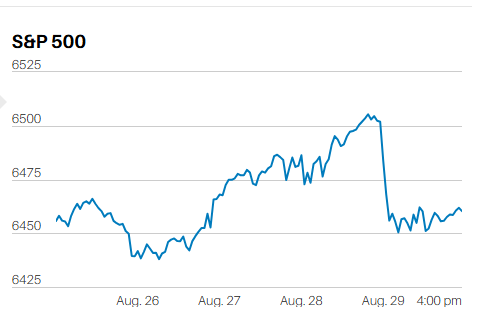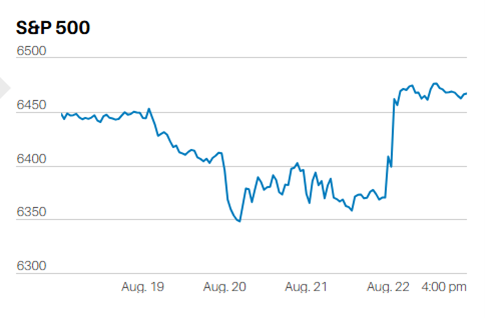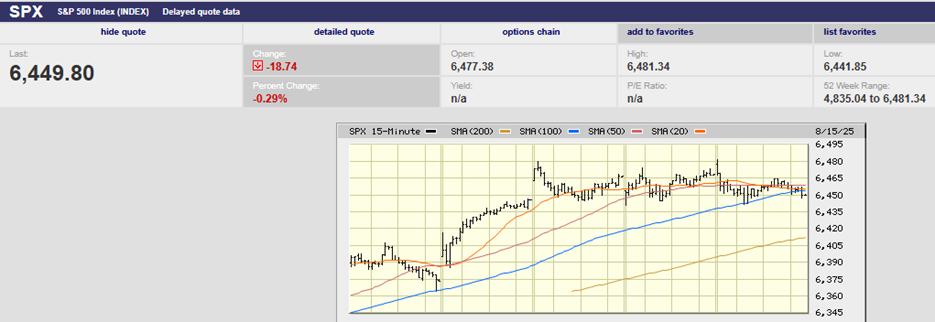75% of the world economy is non-U.S.

Market Update
The S&P 500 rose 1.6% last week to close at 4,136.48. The Nasdaq rose 3.3% while the Dow lost 0.2%. We wrote last week that the S&P was making its run to resistance around 4,100. Powell's press conference took care of resistance in short order. The S&P catapulted higher when Powell acknowledged, "the disinflationary process had started".
Monday saw a continuation of the retreat from the Friday 4094.21 high. The index bottomed Monday at 4015.55. Tuesday saw a higher low at 4020.4. Wednesday’s low was 4037.20. A series of higher lows set up the market for a surge higher to challenge 4,100. The catalyst was the Fed press conference. Traders heard what they wanted to hear from Chairman Powell, and it was off to the races. The S&P surged to a high of 4148.95 before closing Wednesday at 4119.21. The close was above the 4,100 area support. The rally continued Thursday with the index climbing as high as 4,195.44. The S&P was unable to take out Thursday’s high on Friday, halting its daily advance at 4,182.36. The payroll number stopped the rally dead in its tracks, sending the S&P lower on the day.
The market has been rallying since October under the banner of falling inflation. The narrative is that falling inflation means rate cuts later this year. The assumption is that inflation will continue to fall to 2% by mid-year. The Fed is expected to pause soon and then start cutting rates by the fall. It is a simplistic view of the situation and unlikely to work out quite so neatly.
The Fed is unlikely to cut rates without first seeing serious economic weakness. Specifically, it wants to see weakening in the labor market. The labor market is tight and job growth strong. Friday’s payrolls report showed 517,000 jobs added, more than double the estimate. The weekly jobless claims number was only 183,000.
Unadjusted job growth showed a decline of 2.5 million. It is the smallest for any January since the mid-1990s, according to Barron’s. Employers aren’t letting go of workers. There is a labor shortage. There are currently 11.01 million job openings in the United States. There are fewer than 6 million unemployed. A tight labor market means higher wage inflation all else equal. It is ongoing wage gains in the service sector that will keep the Fed tightening. Chairman Powell has said that “he sees rapid wage gains, particularly in the labor-intensive service sector, as the biggest impediment to bringing inflation down to the Fed’s 2 percent target.” Powell is concerned that inflation will plateau at around 4 percent. The Fed wants inflation at 2%.
And that is the crux of the problem for the stock market rally. A slower decline in inflation means higher rates for longer. The futures market reacted to the strong jobs number Friday by pricing in more rate hikes. It now expects hikes in May and June in addition to March, according to Barron's. Higher interest rates mean earnings estimates will need to fall.
The other possibility is that the labor market does soften in the next few quarters. The Fed will stop hiking and may start cutting in response but… earnings estimates will need to come down. Either way earnings estimates will need to fall. Earnings decline around 20% heading into recessions.
There is only a narrow path to a soft landing and a continuation of the market rebound. Inflation must continue falling. The Fed must stop raising rates. Businesses must somehow squeeze out enough profits to prevent earnings from falling.
Unfortunately, inflation is still far too high. The Federal Reserve looks likely to raise rates at least three more times. And the consensus earnings estimate is still too high. Analysts are forecasting 3.2% growth in 2023 followed by 10.8% growth in 2024. Earnings are likely to decline in 2023, not grow, given falling inflation and likely margin pressures. The 2024 growth estimate is pie in the sky. A 16 multiple on $200 in 2023 earnings means an S&P 500 at 3,200. A 16 multiple on $230 in 2024 earnings puts the S&P 500 at 3,680, about 11% lower than Friday’s close. Risk is to the downside for the stock market in the coming quarters.
Economic Indicators
The Employment cost index (ECI) increased 1% in Q4, lower than the 1.2% Q3 increase. The ECI is the most comprehensive measure of employment costs. The ECI is trending in the right direction but is still rising too fast. Compensation climbed at a 5.1% rate in the 12 months ended in December. It was an increase from the 5.0% pace in the prior quarter. It’s near the fastest increase in worker compensation in 40 years, according to Barron's.
There was some good news on the labor front. Productivity increased 3.0% in Q4 up from 1.4% the prior quarter. Unit labor costs fell to 1.1% from 2.0% in Q4. Rising productivity means falling unit labor costs all else equal. The monster payrolls number makes it unlikely the Fed is done raising rates. The unemployment number fell to 3.4%, which is the lowest level since the 1960s.
Home prices fell again, dropping 3.1% in November after falling 2.8% in October. The ISM manufacturing index fell to 47.4 in January from 48.4 the prior month. Motor vehicle sales did increase to 15.7 million annually in January up from 13.4 million. Auto sales have been constrained due to supply problems, not a lack of demand. The supply chain issues continue to improve.
Home Bias and International Markets
The U.S. economy is about 25% of the world economy. The U.S. stock market represented about 65% of the world stock market capitalization at the start of 2022. The U.S. stock market was overvalued measured against the world economy. It still is.
People don’t like to invest overseas. It’s called home bias. We’d rather own Mcdonald's or Walmart than BASF (world’s largest chemical company) or Toyota. Norwood Economics reviews many portfolios every year. We rarely see much exposure to foreign markets. Most financial advisors allocate only a token amount to overseas markets. Conversely, Vanguard and Fidelity target date funds take meaningful stakes in overseas markets. Vanguard allocates around 40% of stock exposure to overseas markets. Fidelity allocates around 50%.
A significant benefit of diversifying overseas is exactly that, diversification. Diversification reduces risk. Country returns over the long run are determined by economic growth. Emerging market economies are growing around twice as fast as the U.S. economy. Investors should want exposure to faster growing economies that provide diversification. Higher returns with lower risk is a good thing.
Foreign markets, especially emerging markets, are cheaper than the U.S. stock market. They are cheaper in large part because they’ve performed poorly since about 2008. The dollar has been strong since around 2011. Emerging economies and emerging markets do best when the dollar is weakening. The dollar has begun weakening in 2023 as investors anticipate an end to the U.S. rate hike cycle. Investors should have substantial international exposure over the long run. Overweighting international and emerging markets in the short-term (next few years) may pay off as well
(Norwood Economics is making no specific recommendations about individual investor allocations).
Regards,
Christopher R Norwood, CFA
Chief Market Strategist











